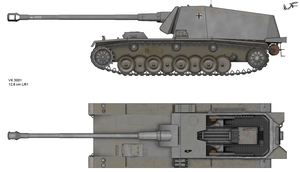Self-propelled gun L / 61
| Pz.Sfl for 12.8 cm K40 | |
|---|---|

Drawing Sfl L / 61 |
|
| General properties | |
| crew | 5 |
| length | 9.70 m |
| width | 3.15 m |
| height | 2.75 m |
| Dimensions | 36.5 t |
| Armor and armament | |
| Armor | 15-50 mm |
| Main armament | 12.8 cm Flak 40 L / 61 |
| agility | |
| drive | 6-cylinder petrol engine 310 hp |
| suspension | Torsion bar suspension |
| Top speed | 25 km / h |
| Power / weight | 8.5 hp / t |
| Range | 170 km (road), 70 km (terrain) |
Armored Selbstfahrlafette (Pz.Sfl) for 12,8cm K40 (formerly Pz.Sfl. V) was the name given to two prototypes produced a Selbstfahrlafette with a 12.8-cm anti-tank gun used by the German armed forces at the time of World War II used were.
history
In 1939 Rheinmetall-Borsig (main weapon) and Henschel (chassis) were commissioned to develop a self-propelled gun under the project name Schwerer Betonknacker . The purpose was the destruction of heavily fortified bunker systems like in the French Maginot Line . Two prototypes of the VK 30.01 (H) developed by Henschel as a successor to the Panzer IV were used as chassis . The built-in main weapon was a modification of the 12.8 cm anti-aircraft gun originally manufactured as an anti -aircraft gun . The vehicles were converted at the turn of the year 1941/42 by Rheinmetall-Borsig in Düsseldorf. The VK 30.01 was extended to the rear by a further wheel and an all-round closed structure that was open at the top was added. In the only lightly armored combat area, 15 rounds of the ammunition, which had to be loaded separately due to their weight and dimensions, could be carried. The weapon itself weighed 7.8 tons. The lateral directional range was a total of 12 °. A major disadvantage of the design was that the entire cannon had to be removed for all engine maintenance.
Due to the previous course of the war, the original purpose was no longer given, so in May 1942 a mission as a heavy tank destroyer with the Panzerjäger -teilung (Sfl.) 521 was ordered. The two vehicles produced, named "Max" and "Moritz" after the famous characters by Wilhelm Busch , were used by the Wehrmacht in the Russian campaign. With the exception of one photo showing car no. 2 with 22 launch markings, there are hardly any operational reports on these vehicles. With the enormously powerful cannon, any Soviet tank could be destroyed even at a great distance. During the mission, the troops named the vehicle "Sturer Emil".
Both vehicles were lost in fighting with the Red Army during the Battle of Stalingrad . One of the specimens captured intact by the Soviets is now in the Kubinka Tank Museum , as are many other tanks, tank destroyers and assault guns .
Technical specifications
- Manufacturer: Henschel / Rheinmetall
- Armament: 1 × 12.8 cm K40 L / 61, two 9 mm MP
- Armouring: front 50 mm, sides 20–30 mm, rear 15 mm
- Ammunition: 15 shells
- Length: 9.7 m (7 m without cannon)
- Width: 3.15 m
- Height: 2.75 m
- Weight: 36.5 t
- Engine: Maybach HL 116S, six-cylinder in-line engine, water-cooled
- Power: 310 hp
- Speed: 25 km / h
- Fuel supply: 450 l
- Crew: 5 men
References
See also
Web links
literature
- Michael Sawodny, Kai Bracher: Panzerkampfwagen Maus and other German tank projects. Revised reprint. Podzun-Pallas Verlag, Wölfersheim-Berstadt 1998, ISBN 3-7909-0098-2 ( Waffen-Arsenal, Highlight 3).
swell
- ↑ Thomas L. Jentz , Hillary Doyle: Panzer Tracts No. 7-3, 7.5 cm Pak 40/4 to 8.8 cm weapon carrier. Boyds (MD) 2006, ISBN 0-9771643-3-0 .
- ^ Michael Sawodny, Kai Bracher: Panzerkampfwagen Maus and other German tank projects. Revised reprint. Podzun-Pallas Verlag, Wölfersheim-Berstadt 1998, ISBN 3-7909-0098-2 ( Waffen-Arsenal, Highlight 3).
